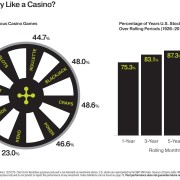Market Timing – Independent Press – 09/03/14
The Independent Press
Money Matters – Question of the Month – September 3, 2014
By Aaron Skloff, AIF, CFA, MBA
Q: The stock market has increased so much in the last five years that I was thinking about selling all of my stocks and mutual funds. What are they key considerations of such a change?
A: The Problem – Market Timing
Somewhat like the weather, the stock market can fluctuate from day to day and from hour to hour. One day the market is up, the next day it is down. Sometimes it just seems safer to simply keep your money in the bank, but this could be a big mistake.
The Solution — Slow and Steady Wins the Race
Remember the story of the tortoise that finished first in a race against the hare? Investing in the stock market can be very advantageous for the slow and steady investor and very disadvantageous for the erratic investor. Let’s look at example of two investors, Logan and Madison. At the beginning of 1994, Logan invested $100,000 in the S&P 500 Index (an index that represents the U.S. stock market) and maintained his investment until the end of 2013. At that point, Logan’s $100,000 generated a compound annual return of 9.2% – leaving him with $582,687. Although Madison invested the same amount at the same time, she moved money in and out of the market as she became fearful during market volatility. By missing the best 25 days, Madison’s $100,000 generated a compound annual return of 1.9% – leaving her with only $146,510. That’s right, simply remaining invested for the best 25 days left Logan more than four times wealthier than Madison.
If you can only remember one thing from this article, here it is: timing the stock market over the long term is a fool’s game!
Click to Enlarge
What about the Average Investor?
According to the 2014 DALBAR Quantitative Analysis of Investor Behavior, the average equity investor generated a compound annual return of 5.0% for the 20-year period ending 2013. The gap between the S&P 500’s 9.2% return and the average equity fund investor’s return expanded in 2013. This was the first gap increase since 2010 and only the third in 10 years. The average fixed income investor also underperformed the Barclays Aggregate Bond Index (an index that represents the U.S. bond market). The average fixed income investor generated a compound annual return of 0.7% versus 5.7% for the Barclays Aggregate Bond Index. According to the DALBAR study, investors tend to sell after experiencing a paper loss and start investing only after the markets have recovered their value.
A Historical Perspective
During the world’s most devastating events the stock market, as measured by the S&P 500 Index, declined meaningfully. More importantly, it has always rebounded. For example, a $1,000 investment in the S&P 500 Index during the Great Depression would have been worth $2,000 10 years later. For another example, a $1,000 investment in the same index on the day of the 1987 stock market crash would have been worth over $5,600 10 years. Astute investors see times of turmoil and market volatility as opportunities.
The Rollercoaster Effect
One of the biggest mistakes you can make is letting your emotions determine your investment decisions. It is just too easy to get caught up in the euphoria when everything is going up and everyone seems to be getting rich. But, buying at the top of the market when stocks are selling at premium valuations or selling after prices have already discounted weak results is a recipe for disaster. For many investors, investing in the stock market feels like a rollercoaster ride. When the rollercoaster (stock market) is climbing they feel confident. Right at the peak of the incline, before they can see the decline, they feel euphoric. This is the time when many investors are drawn into market, only to be disappointed. As the decline begins investors become nervous, then desperate. Right at the trough, before they can see the next incline, they feel defeated. This is the time when many investors bail out of the market, only to be disappointed.
Action Steps – Stay Invested
Timing the entries and exits of the stock market is a fool’s game. Maintaining a long term investment horizon and slow and steady investment approach is a recipe for success. Stay invested and reap the rewards.
Aaron Skloff, Accredited Investment Fiduciary (AIF), Chartered Financial Analyst (CFA), Master of Business Administration (MBA) is CEO of Skloff Financial Group, a Registered Investment Advisory firm based in Berkeley Heights. He can be contacted at www.skloff.com or 908-464-3060.













